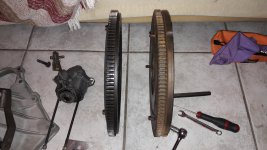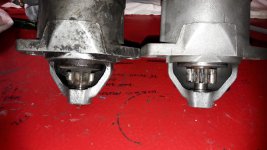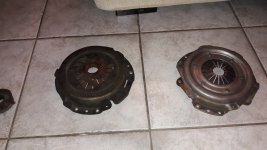Hi Thomas,
It sounds like you have solved the problem but if you wish you could apply some 'Engineer's Blue' (aka Prussian Blue) or even some spray paint on the starter pinion teeth and operate the starter to check if you have adequate engagement of the pinion teeth with the flywheel teeth.
In some cases, it might be possible to re-position the starter ring gear on the flywheel to get better starter pinion engagement. (might not be possible if starter ring gear fits up against a step).
Re :- changing flywheels. I always try to use the flywheel that came with the engine. I don't know for sure if swapping flywheels adversly affects engine balance. But when crankshafts etc are being balanced, afaik all the rotating parts (crank, flywheel,pulley etc) are balanced together and I have seen balance marks (drilled holes) on Fiat flywheels..
On the other hand, (back in the day) new Fiat engines came in a crate without flywheels....
On Fiat 4 cylinder engines there was usually (iirc) a small dimple on the clutch side of the flywheel to indicate tdc on cylinders 1 & 4.
Fitting a lightened flywheel is one of those things that many people feel they have to do if tuning an engine, but is it really necessary or desirable?
Sure, a case can be made that a lighter flywheel takes less power to speed up, thereby allowing a little more power to reach the wheels and the engine will speed up and slow down quicker - sounds good when 'blipping' the throttle. There's also the weight reduction - 2 kg less flywheel weight is also 2 kg less vehicle weight, so slightly less vehicle weight to accelerate/propel.
But why is there a flywheel anyway, other than a convenient place to mount a clutch and also a gear to drive with the starter motor to start the engine?
Flywheels store energy. This energy-store drives the crankshaft between power pulses and also smooths out the crank rotational speed i.e. is a crankshaft damper. A heavy flywheel helps to give a steady idle speed and also helps to prevent stalling of the engine at low engine speeds. It might also help with engine starting especially on single and twin cylinder engines.
So, how do you chose between a standard and lighter flywheel? I suppose it comes down to what you're trying to achieve - if you want an engine that speeds up a little faster then go for the lighter unit, if a steady idle speed is desired, then stay with the standard flywheel. But I don't think that a lighter flywheel, on it's own, is going to make any noticeable difference to acceleration times.
Thomas, iirc you work on Aircraft, do you have access to facilities to check the flywheel on it's own for imbalance before fitting it?
AL.







